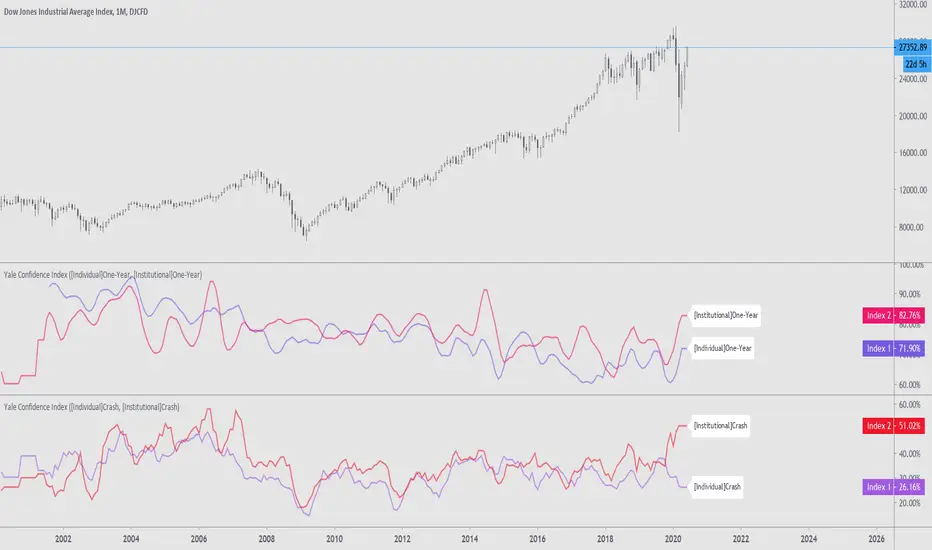OPEN-SOURCE SCRIPT
Yale Confidence Index [nb]

These are the Yale confidence indexes that show individual and institutional sentiment.
Options include:
U.S. One-Year Confidence Index
The percent of the population expecting an increase in the Dow in the coming year.
The One-Year Confidence Index is the percentage of respondents giving a number strictly greater than zero for "in 1 year." Note that the question is worded to mention the possibility that the respondent could predict a downturn, and so this question will obtain more such responses than more optimistically worded questions used by some other surveys. However, the issue is how the answers change through time, and the wording of the question has not been changed through time (except to add the 1-month and the ten-year categories, which were not on the earliest questionnaires).
U.S. Buy-on-Dips Confidence Index
The percent of the population expecting a rebound the next day should the market ever drop 3% in one day.
The Buy-On-Dips Confidence Index is the number of respondents who choose 1 (increase) as a percent of those who chose 1, 2 or 3. This question was never changed.
U.S. Crash Confidence Index
The percent of the population who attach little probability to a stock market crash in the next six months.
The Crash Confidence Index is the percentage of respondents who think that the probability is strictly less than 10%. There were slight wording changes in this question, but inessential.
U.S. Valuation Confidence Index
The percent of the population who think that the market is not too high.
The Valuation Confidence Index is the number of respondents who choose 1 (Too Low) or 3 (About right) as a percentage of those who choose 1, 2, or 3. The wording of this question was never changed, and it was always the first question on the questionnaire.
Source:
som.yale.edu/faculty-research-centers/centers-initiatives/international-center-for-finance/data/stock-market-confidence-indices/united-states-stock-market-confidence-indices
Includes methodology and questions used.
Japanese indexes aren't updated so I did not include them.
Options include:
- showing two different indexes at once
- labels for them
- to filter through a moving average
- highlighting when the first chosen index is greater than the second
- shifting the series 6 months ahead
- showing an average of both indexes
U.S. One-Year Confidence Index
The percent of the population expecting an increase in the Dow in the coming year.
The One-Year Confidence Index is the percentage of respondents giving a number strictly greater than zero for "in 1 year." Note that the question is worded to mention the possibility that the respondent could predict a downturn, and so this question will obtain more such responses than more optimistically worded questions used by some other surveys. However, the issue is how the answers change through time, and the wording of the question has not been changed through time (except to add the 1-month and the ten-year categories, which were not on the earliest questionnaires).
U.S. Buy-on-Dips Confidence Index
The percent of the population expecting a rebound the next day should the market ever drop 3% in one day.
The Buy-On-Dips Confidence Index is the number of respondents who choose 1 (increase) as a percent of those who chose 1, 2 or 3. This question was never changed.
U.S. Crash Confidence Index
The percent of the population who attach little probability to a stock market crash in the next six months.
The Crash Confidence Index is the percentage of respondents who think that the probability is strictly less than 10%. There were slight wording changes in this question, but inessential.
U.S. Valuation Confidence Index
The percent of the population who think that the market is not too high.
The Valuation Confidence Index is the number of respondents who choose 1 (Too Low) or 3 (About right) as a percentage of those who choose 1, 2, or 3. The wording of this question was never changed, and it was always the first question on the questionnaire.
Source:
som.yale.edu/faculty-research-centers/centers-initiatives/international-center-for-finance/data/stock-market-confidence-indices/united-states-stock-market-confidence-indices
Includes methodology and questions used.
Japanese indexes aren't updated so I did not include them.
オープンソーススクリプト
TradingViewの精神に則り、このスクリプトの作者はコードをオープンソースとして公開してくれました。トレーダーが内容を確認・検証できるようにという配慮です。作者に拍手を送りましょう!無料で利用できますが、コードの再公開はハウスルールに従う必要があります。
My published indicators: tradingview.com/u/NeoButane/
Sorry if I haven't replied to your message yet, I'm a bit backlogged :)
Sorry if I haven't replied to your message yet, I'm a bit backlogged :)
免責事項
この情報および投稿は、TradingViewが提供または推奨する金融、投資、トレード、その他のアドバイスや推奨を意図するものではなく、それらを構成するものでもありません。詳細は利用規約をご覧ください。
オープンソーススクリプト
TradingViewの精神に則り、このスクリプトの作者はコードをオープンソースとして公開してくれました。トレーダーが内容を確認・検証できるようにという配慮です。作者に拍手を送りましょう!無料で利用できますが、コードの再公開はハウスルールに従う必要があります。
My published indicators: tradingview.com/u/NeoButane/
Sorry if I haven't replied to your message yet, I'm a bit backlogged :)
Sorry if I haven't replied to your message yet, I'm a bit backlogged :)
免責事項
この情報および投稿は、TradingViewが提供または推奨する金融、投資、トレード、その他のアドバイスや推奨を意図するものではなく、それらを構成するものでもありません。詳細は利用規約をご覧ください。